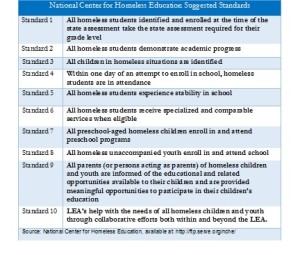Chairman Grosso and members of the Committee on Education, thank you for the opportunity to speak today. My name is Soumya Bhat, and I am the Education Finance and Policy Analyst at the DC Fiscal Policy Institute. DCFPI is a non-profit organization that promotes opportunity and widespread prosperity for all residents of the District of Columbia through thoughtful policy solutions.
I’d like to focus my testimony today on two areas within the Office of the State Superintendent for Education (OSSE) – assessing and identifying the needs of homeless students and evaluating the city’s Community Schools program.
Assessing and Identifying Needs of Homeless Students
Homeless liaisons in DC Public Schools and public charter schools need a comprehensive set of tools to help address the unique needs of each homeless child and their family. This is especially important in the District, given the very large number of homeless students and the barriers to learning that homelessness can create if not addressed. The National Center for Homeless Education (NCHE) recommends that each state and LEA conduct an assessment of their services for homeless students — to identify what services are being provided, how well they work, and what gaps in services remain. Conducting a system-wide needs assessment could help DC determine how many additional resources are needed to adequately serve homeless students and how best to allocate those staff and resources.
The agency’s performance oversight responses indicate some work is underway, with six defined goals and an evaluation of progress to be completed this summer.[1] DCFPI recommends a comprehensive needs assessment process be conducted by a committee comprising a broad range of stakeholders, including the OSSE coordinator for the McKi nney-Vento program, school level homeless liaisons, teachers, shelter providers, school nurses, homeless families and others who are homeless or community partners who provide services for homeless students. The NCHE suggests that the needs assessment focus on the following areas:
nney-Vento program, school level homeless liaisons, teachers, shelter providers, school nurses, homeless families and others who are homeless or community partners who provide services for homeless students. The NCHE suggests that the needs assessment focus on the following areas:
- Awareness of homelessness among students;
- Policies and procedures in place under the McKinney-Vento act;
- Identification of, and outreach to, homeless youth;
- Enrollment in schools and access for students to in school services;
- Student success outcomes;
- Collaboration with other government agencies and community organizations that serve homeless youth;
- Resources and capacity for addressing homelessness within the school; and
- Guidance and monitoring of programs.
In addition, the NCHE recommends building in a system for program evaluation during the needs assessment process to help review programs and look for ways to strengthen them. NCHE provides several guides for schools who want to do program evaluation but notes that one of the more thoughtful ones uses the Data Standards and Indicators Guidebook with 10 standards for evaluation (see table below). These standards range from ensuring all homeless students demonstrate academic progress to all homeless unaccompanied youth enroll and are in school. Schools can decide how to measure and what progress they aim to achieve each year.
Program Evaluation of the Community Schools Program
Community Schools use public schools as central hubs for students and the larger community to access integrated services and supports. They do this by developing partnerships between the school and community-based resources. The partners often connect students and their families with outside supports, including medical, dental and mental health services, before- and after-school programs, or classes focused on financial literacy, GED prep, or computer skills.
With last year’s expansion, there are currently 13 schools operating Community School partnerships in the District. Funding was also added in FY 2016 to conduct a city-wide program evaluation of the model. The agency’s responses to oversight questions mention an approach to evaluation currently being drafted and reviewed, with results potentially ready for grantees to review by the end of this school year.[2] The “service-based” approach would look at the impact of services on certain student and community outcomes that go beyond test scores, such as improved behavior of students, parent involvement, and larger community benefits. We support this larger perspective on measuring the impact of Community Schools and look forward to the results of the evaluation. We encourage OSSE to make this process as transparent as possible by sharing data from the evaluation with the public as well as Community School grantees at the end of the 2015-16 school year.
Thank you again for the opportunity to testify. I am happy to answer any questions.
[1] See Q41 of OSSE’s Performance Oversight Responses: http://bit.ly/GrossoPerformance16.
[2] See Q42 of OSSE’s Performance Oversight Responses: http://bit.ly/GrossoPerformance16.
